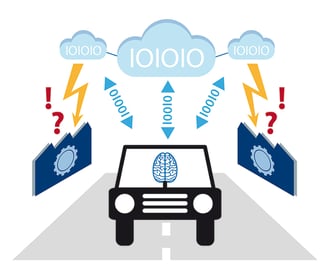Why Transport Logistics Should Be a Top Priority
Brian Hoey - March 01, 2018

 In a recent research report, Business Insider found that when it came to machine learning, 53% of the company executives surveyed were interested in the emerging technology, but unclear as to its exact use cases and applications. Similar figures applied to executive attitudes towards other technological advances, such as artificial intelligence and 3D printing. Although machine learning in particular is already driving new Industry 4.0 workflows and fundamentally changing the way that manufacturers do business, it’s no surprise that many have trouble envisioning specific applications for it. The transformative power of new technological advances comes not from generalities, but from specific tools and methods for integration that must be carefully calibrated to specific business functions.
In a recent research report, Business Insider found that when it came to machine learning, 53% of the company executives surveyed were interested in the emerging technology, but unclear as to its exact use cases and applications. Similar figures applied to executive attitudes towards other technological advances, such as artificial intelligence and 3D printing. Although machine learning in particular is already driving new Industry 4.0 workflows and fundamentally changing the way that manufacturers do business, it’s no surprise that many have trouble envisioning specific applications for it. The transformative power of new technological advances comes not from generalities, but from specific tools and methods for integration that must be carefully calibrated to specific business functions.
For this reason, it’s important not to conceive of something like machine learning as a mythical panacea for improving production processes and reducing costs, but as a driver for specific tools: transport logistics, for instance. Transport logistics solutions can serve as a key driver of Industry 4.0 principles and represent a specific, actionable use case that cuts through both the hype and the uncertainty around otherwise daunting new innovations. Here are a few reasons why it should be a top priority for your business:
Risk Management
One of the most significant value added propositions for any supply chain manager is effective risk management. In a world that increasingly presents daily disruptions from all corners of the globe, the ability to identify potential bottlenecks or breakdowns in advance and adapt your value stream accordingly has the potential to save time and money. Because of meteorological events, fluctuations in fuel pricing, and unpredictable traffic patterns, transportation planning is a point on the value chain that is especially susceptible to disruption. Luckily, a robust transport logistics solution can help a reasonably adaptable supply chain cope with these disruptions in an agile manner.
Where pen-and-ink transportation planning calls for fixed delivery windows based on rigid production schedules and constraints, smart transport solutions can add transparency and flexibility to shipping timetables and routing. By offering data about fuel consumption, fuel prices, shipping routes, load capacity, and even weather patterns, this technology can aid planners in making real-time adjustments to their plans. Imagine, for instance, that one of your production processes will yield a certain number of parts that must be delivered to a distribution facility by a given date. A disruption occurs, and you’re forced to decide between lengthening your lead time in order to utilize a full truck or container, or opting for a half truck load, potentially incurring losses or missed deadlines in either instance. A solution of the sort under discussion can help identify optimal scheduling changes based on capacity, usage, and other restrictions in order to minimize potential losses and maintain on-time performance.
Industry 4.0 Integration
With Industry 4.0 principles rapidly changing the nature of manufacturing, it would be reasonable to wonder if and how transport logistics fits into Industry 4.0 workflows and processes. After all, if your manufacturing business is driving toward an Industry 4.0 supply chain, it could be unwise to prioritize unrelated new technology. Rest assured, Industry 4.0 and smart transportation planning go hand-in-hand when it comes to increasing visibility and adaptability intra-operationally and across the entire value stream. Just as Industry 4.0 helps to bring disparate points in the supply stream into a visible, cohesive system or architecture (thereby giving transportation planners more complete, up-do-date data with which to make decisions), transport solutions help to drive increased digitization throughout all shipping and transportation processes, which enables planners to take an even more holistic view of their value chains. The result is a synergistic relationship that enables businesses to adjust to rapidly shifting constraints with little or no lead time.
Customer Satisfaction
While risk management and supply chain integration are already compelling reasons to prioritize transport logistics, perhaps that most the most important reason relates to one of a business’ other top priorities: the customer. As with Industry 4.0 integration, many manufacturers would rightly be loathe integrate a solution that didn’t boost customer satisfaction. Luckily, adopting a more agile, visible system for managing transport can boost customer satisfaction in a number of ways:
- Disruption management and agile routing can help increase your proportion of on-time deliveries.
- Removing static delivery windows yields potentially shortened lead times, leading to faster expected delivery times.
- Increased end-to-end (E2E) visibility means improved user experiences from a client-side planning perspective.
Many businesses can and do struggle to provide this level of stability in increasingly volatile and variant rich industries. Those that can through this complexity, however, are able to add value for customers with reliable estimates and on-time performance. Just as smarter, more flexible transportation planning can help to stave off disruptions across one’s own operations, it can help prevent client-side disruptions, leading to increased customer loyalty.
LATEST POSTS
- Understand Circular Economy in The Manufacturing Industry
- How Can Industry 4.0 IT Integration Be Achieved Smoothly?
- The Significance of Order Sequencing in Discrete Manufacturing
- How to improve your Supply Chain Management: The Power of Control Towers
- Optimizing Human Resource Scheduling in Manufacturing: A Technological Approach



